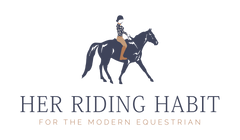Jennifer Mitchell, Equestrian Physical Therapist, shares her 5 Favorite Unmounted Exercises
Greetings to Her Riding Habit! I’m Jennifer, an orthopedic and sports physical therapist (Physio), specializing in working with equestrian athletes! I have been a physical therapist for 28 years; long before my PT career began, I was a rider (and continue to be a rider today!).

It has been amazing to be able to join my two passions: riding and performance physical therapy. Eight years ago, I was fortunate to be selected to train (as a physio) with the former Lead Physio for the US Equestrian Federation—I am one of only four physios here in the US, credentialed to work with the teams and squads of the US Equestrian Federation.

Being an equestrian performance physio has brought me around the world—Aachen, Germany for the World Equestrian Festival, Herning, Denmark and Pratoni, Italy for 2022 World Championships, and Santiago, Chile for the 2023 Pan American Games. Here in the US, I continue to work with riders of all levels, helping them to be the best riders they can be, through rider biomechanics work in and out of the saddle!
I am excited to share with you, my five favorite unmounted exercises for equestrian athletes!
Here we go:
Dynamic Spinal and Hip Mobility:
Want to improve your sitting trot? Work on your spinal segmental mobility! In the sitting trot, your pelvis needs to have a controlled oscillation to begin the absorption of ground reaction forces from the horse—a rocking on your seat bones. Moving upwards, your lumbar, thoracic and even cervical spine (up to the base of your skull) must have good segmental mobility (and dynamic control, I might add), in order to act as a spring to continue to absorb
those forces.
Rider Specific Bridge:
Bridges are a great exercise for riders—they achieve several goals: improved core strength, improved pelvic stability, improved anterior hip opening and improved anterior chain mobility.
Lunge to Pull Back:
A supple thigh against the saddle (and horse) helps to absorb ground reaction forces, aswell as allow for fluidity of moment with the horse, making for a fluid, quiet, supple, efficient
ride. Frequently we have restrictions in the saddle, that cause us to draw our knees up or
forwards (anterior chain restriction), or drawing our lower leg up and back (posterior chain
restriction). Give this exercise a try to improve connection in the saddle!
Dynamic Hip Mobility: Side Lunge to Spinal Twist:
Want to dial in your seat in the saddle? Work dynamic hip openers and spinal mobility. This exercise can be modified by standing in front of a table, in a side lunge (instead of kneeling).
Shin Box Switch:
Your thigh has the greatest amount of surface area contact with the saddle (and your horse!)—having symmetric, supple, fluid movement in your hips allows a rider to better follow the movement of the horse, and to be a more effective rider!
Follow Jennifer on Instagram at @fivestarriderphysio and Facebook at 5 Star Rider Physio!
Featured Image Photo Credit: Hannah Marie Photography


